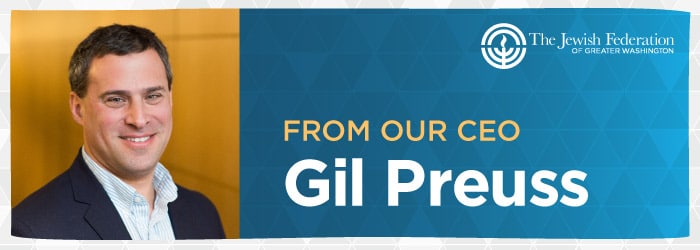-
13 February 2018

“The mission of Jewish leaders in the 21st century should be how to ensure the continued, significant renaissance of the Jewish people, ensuring a sense of belonging by every Jew to his people, its heritage, its values, its State, and its dreams and aspirations to work as Jews to make this a better world for all.” – Avraham Infeld
I am pleased and proud to share with you the results of the 2017 Greater Washington Jewish Community Demographic Study, funded by The Morningstar Foundation. The study comes at a pivotal time for our Jewish community – one of the fastest growing Jewish communities in the United States.
Conducted by the Cohen Center for Modern Jewish Studies and the Steinhardt Social Research Institute at Brandeis University, the study creates a comprehensive portrait of the characteristics, attitudes and behaviors of Greater Washington’s Jewish community.
We now have a clear picture of how our markedly diverse population has evolved, both demographically and in the ways in which we connect with Jewish life and with Israel. Today, Greater Washington is home to nearly 300,000 Jewish adults and children in over 155,000 households, having grown by nearly 40% over the past 15 years.
In one of the more striking results, the Northern Virginia Jewish population has grown substantially since 2003, and now represents 41% of the local Jewish community, with 121,500 individuals living in 63,700 households throughout Fairfax, Prince William and Loudon Counties and the cities of Arlington, Alexandria, Fairfax, Falls Church, Manassas and Manassas Park. This compares to 37% in Suburban Maryland and 22% in the District of Columbia.
Additional notable findings from the study include:
- The Jewish community is both older and younger than most American Jewish communities, having more seniors and more adults under age 35 than American Jews nationally.
- The median age of Greater Washington Jewish adults is 45, which is 5 years younger than the national average of 50.
- 53% of married Jews are married to someone who does not identify as Jewish.
- 85% of children in Jewish households (including those with intermarried parents) are being raised Jewish in some manner, with a third of children enrolled in some sort of Jewish educational activity.
- 68% of local Jews have either visited or lived in Israel. This figure represents a substantially higher proportion than among US Jews in general, of whom in 2013, 43% had been to Israel.
- 26% of households belong to a synagogue or another Jewish worship community – a lower percentage than the rest of the country (39%).
- Many of those surveyed who do not normally attend synagogue services find meaningful connections through cultural activities such as art, music, dance, film and books with Jewish themes.
- 18% of households include a family member with a health limitation or disability.
- 7% percent of those surveyed identify as LGBTQ, and 7% as a person of color.
These data are a gift to the community. They provide important information about who we are today. What they don’t tell us, however, is where we want to go. What type of Jewish community do we seek to build? What is our vision for a vibrant Jewish community of meaning and purpose for all of its members? How do we integrate a deep understanding of today’s Jewish community with our vision for tomorrow?
I am thankful to have already had an opportunity to participate in a series of initial conversations with communal leaders – professionals, volunteers and philanthropists committed to ensuring our continued success – about how we might use these data to better serve Jewish Greater Washington. The findings reinforce what many of us already know: we can no longer rely solely on traditional institutions and methods of engagement. Ours is a community of vibrant, diverse and passionate people – one that seeks innovative programs and opportunities to connect with one another, with Jewish life and with Israel.
There will be many conversations still to come as we work together to ask and answer these questions, and I hope that many of you will be active participants in the process. I look forward to the ways in which The Jewish Federation will use these data to inform our work as we enter a new strategic planning process, driven by identifying and attaining our communal hopes, dreams, vision and values.
The Jewish Federation is especially grateful to The Morningstar Foundation, whose funding and commitment to strengthening the future of our Jewish community made this research possible. Our sincere thanks, as well, to the talented team of researchers from the Cohen Center for Modern Jewish Studies and the Steinhardt Social Research Institute at Brandeis University: Dr. Janet Krasner Aronson, Dr. Matthew Boxer, Matthew Brookner and Dr. Leonard Saxe.
Finally, thank you to the thousands of individual respondents from across the region for participating in this study. Your contributions to this research, and to the future success of our community, will enable Jewish Greater Washington to continue growing and thriving for years to come.
